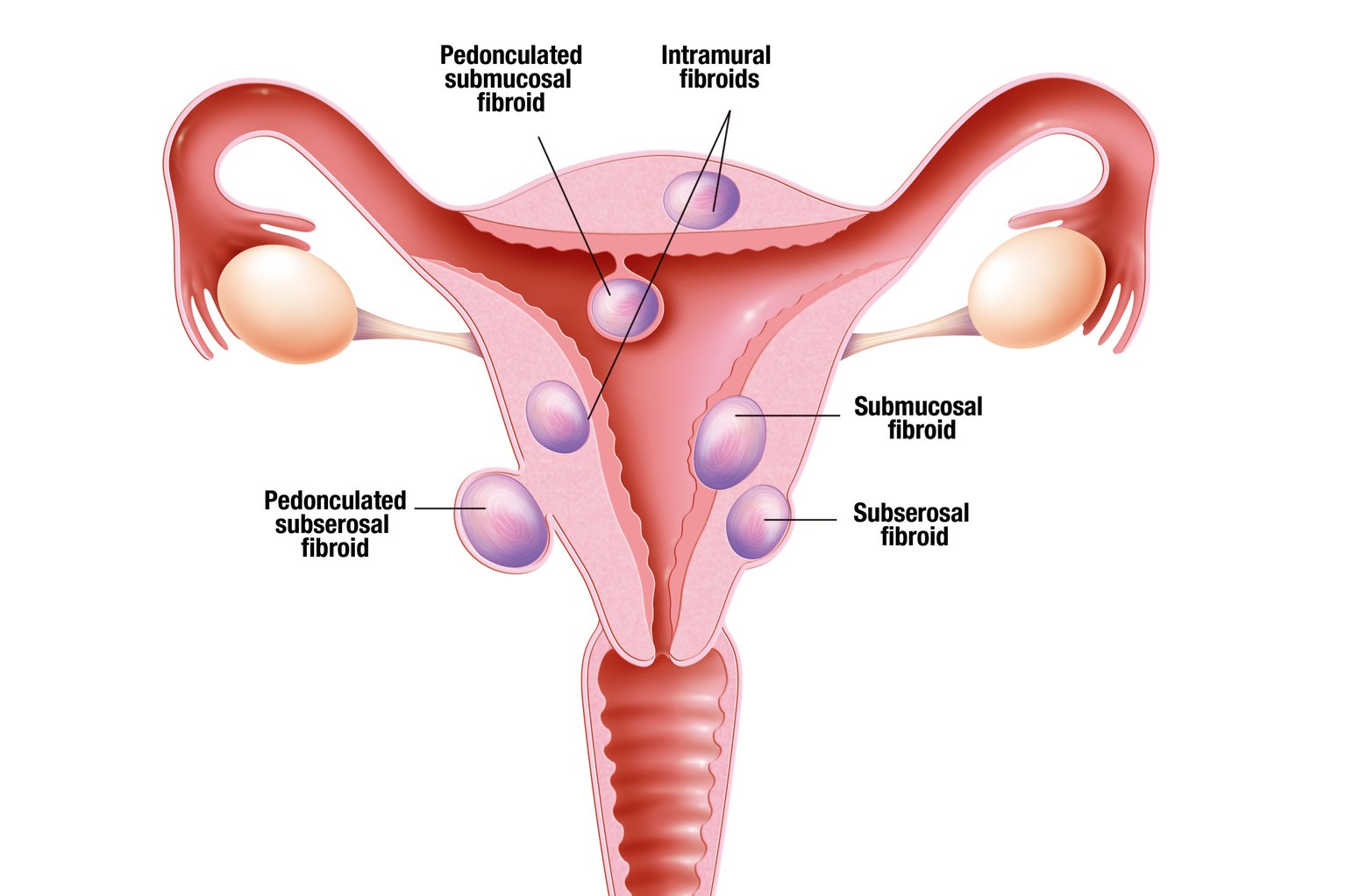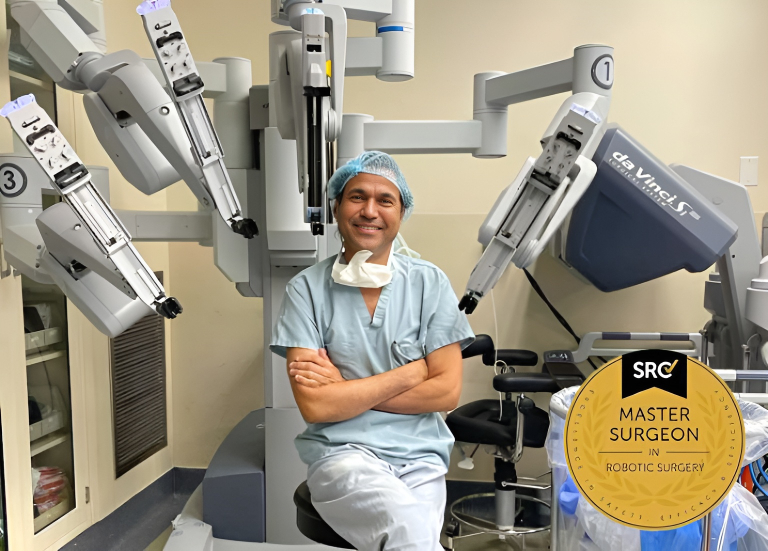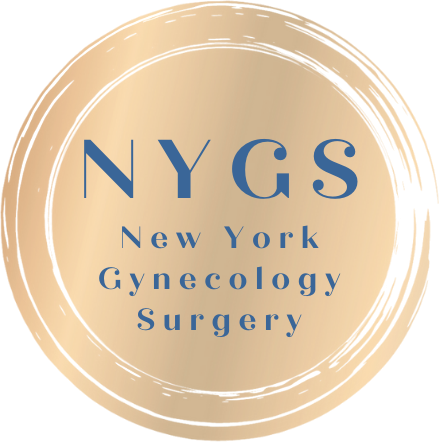Uterine Fibroids in
Long Island New York
We take pride in providing an accessible and efficient solution through our minimally invasive, robotic-assisted treatment of uterine fibroids, and it’s worth noting that numerous patients come from distant locations to undergo this procedure with us.
Don’t hesitate to reach out to Dr. Pankaj Singhal for a thorough evaluation of your suitability for the procedure. To arrange your consultation for uterine fibroids treatment at our private office in Bay Shore, Long Island, New York, please feel free to get in touch by dialing (631) 533-9733 or simply submit your appointment request via our secure online form.
Understanding Uterine Fibroids
Uterine fibroids, also known as leiomyomas, are noncancerous growths that develop in the muscular wall of the uterus. They are the most common type of noncancerous tumor in women of reproductive age.
Fibroids can range in size from small, pea-sized growths to large tumors that can distort the shape of the uterus. They can be located within the uterine wall, on the outer surface of the uterus, or protruding into the uterine cavity.
Fibroids are often asymptomatic, but they can cause heavy menstrual bleeding, prolonged periods, pelvic pain or pressure, frequent urination, constipation, and backache. In some cases, they can also cause infertility or complications during pregnancy.
The exact cause of fibroids is unknown, but they are thought to be related to hormonal imbalances and genetics. Treatment options for fibroids include medication, surgery, or minimally invasive procedures such as uterine artery embolization or magnetic resonance-guided focused ultrasound.

Image source: NHS United Kingdom
How to Diagnose Uterine Fibroids?
Uterine fibroids can be diagnosed through a combination of medical history, physical examination, and imaging tests. Here are some common diagnostic procedures for uterine fibroids:
- Medical history and physical examination: Your doctor will ask you about your symptoms and medical history. They will also perform a pelvic examination to check for the size and location of fibroids.
- Ultrasound: This imaging test uses high-frequency sound waves to create images of the uterus and ovaries. It can help identify the size, number, and location of fibroids.
- Magnetic resonance imaging (MRI): An MRI scan can provide detailed images of the uterus and surrounding organs. It is especially useful in identifying small fibroids or those located deep within the uterine wall.
- Hysteroscopy: In this procedure, a thin, lighted tube with a camera on the end is inserted into the uterus through the vagina to directly visualize the uterine cavity and identify fibroids.
- Endometrial biopsy: This involves removing a small sample of tissue from the lining of the uterus to check for abnormal cells or signs of cancer. It is usually performed if there is abnormal vaginal bleeding or if there is a suspicion of cancer.
- Blood tests: Certain blood tests, such as a complete blood count or thyroid function test, may be ordered to rule out other conditions that can cause similar symptoms.
Based on the results of these tests, your doctor will be able to diagnose whether you have uterine fibroids and develop a treatment plan based on your individual needs.
What are the Symptoms of Uterine Fibroids?
Not all women with uterine fibroids experience symptoms. When symptoms do occur, they may vary in intensity and frequency depending on the size, number, and location of the fibroids. Some common symptoms of uterine fibroids include:
- Heavy menstrual bleeding: This is the most common symptom of fibroids, and it can result in prolonged periods or bleeding between periods.
- Pelvic pain or pressure: Fibroids can cause discomfort or pain in the lower abdomen, back, or legs. They can also cause pressure on the bladder or rectum, leading to frequent urination or constipation.
- Enlarged abdomen: Large fibroids can cause the uterus to expand, resulting in a swollen or enlarged abdomen.
- Pain during sex: Fibroids located near the cervix or in the uterine wall can cause pain or discomfort during sex.
- Infertility: In some cases, fibroids can interfere with implantation or block the fallopian tubes, leading to difficulty getting pregnant.
- Miscarriage: Fibroids can increase the risk of miscarriage, especially if they are located near the cervix or in the lower part of the uterus.
If you experience any of these symptoms, it is important to speak with Dr Pankaj Singhal to determine if uterine fibroids are the cause and discuss appropriate treatment options.
Cost of Uterine Fibroids Treatment in Long Island, New York
The cost of uterine fibroids removal in the United States can vary widely depending on the type of treatment and the location where the procedure is performed. Here are some estimated costs for common treatments:
Myomectomy: This surgical procedure involves removing the fibroids while leaving the uterus intact. The cost of myomectomy can range from $5,000 to $15,000, depending on the complexity of the surgery and the hospital or clinic where it is performed.
Hysterectomy: This surgery involves removing the entire uterus and is a permanent solution for fibroids. The cost of hysterectomy can range from $10,000 to $20,000 or more, depending on the type of surgery and the hospital or clinic where it is performed.
Uterine artery embolization (UAE): This minimally invasive procedure involves blocking the blood supply to the fibroids, causing them to shrink and die. The cost of UAE can range from $8,000 to $15,000, depending on the hospital or clinic where it is performed.
Magnetic resonance-guided focused ultrasound (MRgFUS): This noninvasive procedure uses focused ultrasound waves to heat and destroy the fibroids. The cost of MRgFUS can range from $10,000 to $15,000, depending on the hospital or clinic where it is performed.
It’s important to note that these costs are estimates and can vary significantly depending on individual factors such as the location, the type of procedure, insurance coverage, and other factors. It is recommended to schedule an appointment with the NYGS team and insurance provider to get a more accurate estimate of the cost of uterine fibroids removal.
Pankaj Singhal, MD, MS, MHCM
- Industry expertise with over 12 years of experience in both academic & private health care settings, physician practice management and executive leadership.
- Trained over 45 gynecologic surgeons along with training fellows in minimally invasive gynecologic surgery and gynecology oncology, and has developed cutting edge, new surgical techniques for endometriosis and laparoscopic surgeries.
- One of the very few surgeons who have completed over 5,718 robot-assisted gynecologic surgeries in the entire United States.
- Known for taking on the most challenging surgery cases that other doctors/centers turn away.

Hear From Our Clients

Joetta Simonette
On May 3, 2018 at Good Samarital Hospital, due to cancer, you performed ovarian surgery on me.
It is now 5 years since that date – 5 years of wellness that has been accomplished through the grace of God guiding your hands and the support of your team and my loving family.
You are an excellent, compassionate and caring doctor who was confident of a good outcome, and so it is!
Thank you, thank you for these past wonderful years. May God continue to bless you. You are in my prayers!

RG Petkos
Power couple Dr. Singhal & Dr. Mclean are amazing!! My experience with them has been absolutely wonderful. I highly recommend either of them for so many reasons mainly for helping me get back some quality of life with my successful full hysterectomy being better than I expected.
The process from the beginning with them was a pleasure and I had quite a challenge beforehand so I’m very grateful that quality, professional, caring doctors still exist!!
I especially appreciate their proactive approach and feel the combination of the care and expertise they provide make for successful outcomes!!

Kimberly Quinde
Dr. Singhal was the doctor who took care of my mother Ivonne Guevara. My mother had gone to 2 other doctors who refused to take care of her fibroid. She was in pain for years and her fibroid had grown really big without her knowing. When my mom went to Dr Singhal she was met with calmness and reassurance that everything will be ok and he would help her get better. Dr. Singhal was so kind and caring all throughout the process.
He took all her worries away and my mom highly recommends him. She hopes every doctor can be as great as Dr. Singhal.
Everyone in his office was so nice to my mom and it was a great experience given the circumstances.
Frequently Asked Questions
Get answers to the most frequently asked questions about Uterine Fibroids.
The exact cause of uterine fibroids is unknown, but there are several factors that may contribute to their development. Some possible causes of uterine fibroids include:
- Hormonal imbalances: Uterine fibroids are more common during reproductive years when hormone levels are higher, particularly estrogen and progesterone. Fibroids tend to shrink after menopause when hormone levels decrease.
- Genetics: Uterine fibroids may run in families, and certain genetic mutations have been linked to their development.
- Age and race: Uterine fibroids are more common in women over the age of 30 and in African American women. They also tend to grow more quickly in African American women.
- Obesity: Being overweight or obese can increase the risk of developing fibroids.
- Lifestyle factors: Certain lifestyle factors, such as a diet high in red meat and low in fruits and vegetables, and lack of exercise, may increase the risk of developing fibroids.
- Medical conditions: Certain medical conditions, such as endometriosis, adenomyosis, and polycystic ovary syndrome (PCOS), may increase the risk of developing fibroids.
While the exact cause of uterine fibroids is not fully understood, it is believed that a combination of these factors can contribute to their development.
Both myomectomy and hysterectomy are surgical procedures that can carry risks of complications. Common complications include bleeding, infection, damage to other organs, adhesions, anesthesia complications, blood clots, and sexual dysfunction. In addition, hysterectomy may cause early menopause if the ovaries are removed.
It is important to discuss the potential risks and benefits of these procedures with a surgeon like Dr. Pankaj Singhal before undergoing surgery, and to closely monitor any symptoms or complications that may arise during the recovery period.
Most uterine fibroids are not cancerous and do not increase the risk of developing cancer. Uterine fibroids are benign tumors that grow in the muscle tissue of the uterus. However, in rare cases (less than 1% of cases), a uterine fibroid may develop into a cancerous tumor called a leiomyosarcoma.
It is important to note that not all fibroids have the potential to become cancerous. The risk of a fibroid becoming cancerous is more likely in postmenopausal women, and in women with rapidly growing fibroids or fibroids that are larger than 10 cm in diameter.
Uterine fibroids can affect pregnancy in a number of ways, depending on the size, location, and number of fibroids present. Some possible effects include:
- Infertility: Fibroids can interfere with the ability to conceive by blocking the fallopian tubes or disrupting the uterine lining.
- Miscarriage: Large fibroids located in the uterine cavity or near the cervix can increase the risk of miscarriage.
- Preterm labor: Fibroids can cause the uterus to contract prematurely, leading to preterm labor and delivery.
- Placental abruption: Fibroids can increase the risk of placental abruption, a serious condition in which the placenta detaches from the uterus before delivery.
- C-section delivery: Fibroids can obstruct the birth canal or interfere with the baby’s position, making a C-section delivery necessary.
- Heavy bleeding: Fibroids can cause heavy bleeding during pregnancy or after delivery, leading to anemia or requiring blood transfusions.
In some cases, fibroids may not have any significant impact on pregnancy. However, if you have fibroids and are planning to become pregnant, it is important to discuss your options with your healthcare provider. Depending on the size and location of the fibroids, your healthcare provider may recommend monitoring or treatment options to reduce the risk of complications during pregnancy.
Uterine fibroids can potentially cause infertility by interfering with the ability of a fertilized egg to implant in the uterus or by blocking the fallopian tubes. The location and size of the fibroids can play a role in their effect on fertility.
Fibroids that grow inside the uterine cavity, called submucosal fibroids, are the most likely to cause infertility. These fibroids can distort the shape of the uterus, making it difficult for a fertilized egg to implant or for an embryo to develop properly. They can also interfere with the blood supply to the uterus, reducing the chances of successful implantation.
Fibroids that are located near the cervix or the opening of the fallopian tubes can also cause infertility by blocking the passage of sperm or eggs.
However, it is important to note that not all fibroids will cause infertility. Many women with fibroids are able to conceive and carry a pregnancy to term without difficulty. If you are having trouble conceiving and suspect that fibroids may be a factor, talk to your healthcare provider. They can help determine if fibroids are present and what treatment options may be appropriate.
Radiofrequency ablation (RFA) of fibroids is a minimally invasive procedure that uses heat generated by high-frequency electrical currents to destroy fibroid tissue. During the procedure, a thin, needle-like device is inserted into the fibroid using ultrasound guidance. The device then emits radiofrequency energy, which heats and destroys the fibroid tissue.
RFA can be performed as an outpatient procedure using local anesthesia or conscious sedation, and typically takes less than an hour to complete. Because the procedure is minimally invasive, recovery time is usually short, with most women returning to normal activities within a few days.
RFA is not appropriate for all types of fibroids. It is typically recommended for women who have symptomatic fibroids that are causing heavy bleeding, pain, or pressure, and who wish to avoid more invasive surgical procedures like hysterectomy or myomectomy. RFA is not recommended for women who wish to become pregnant in the future, as it can damage the uterine lining and potentially affect fertility.
While RFA is generally considered safe and effective, there are some potential risks and complications associated with the procedure, including bleeding, infection, and damage to surrounding tissue. As with any medical procedure, it is important to discuss the risks and benefits of RFA with your healthcare provider to determine if it is an appropriate treatment option for you.
Uterine fibroid embolization (UFE), also known as uterine artery embolization, is a minimally invasive procedure that can be used to treat symptomatic fibroids. During the procedure, small particles are injected into the arteries that supply blood to the fibroids, blocking blood flow and causing the fibroids to shrink and die.
Some potential benefits of UFE include:
- Non-surgical: UFE is a non-surgical alternative to hysterectomy or myomectomy for women who want to avoid major surgery.
- Minimally invasive: UFE is performed using a small incision in the groin area, which means that there is less pain, scarring, and recovery time compared to traditional surgery.
- Effective: UFE has been shown to be effective in reducing fibroid-related symptoms such as heavy bleeding, pain, and pressure.
- Preservation of fertility: Unlike hysterectomy, UFE does not involve removal of the uterus, which means that it may be an option for women who wish to preserve their fertility.
- Outpatient procedure: UFE can often be performed as an outpatient procedure, which means that patients can go home the same day as the procedure.
However, it is important to note that UFE is not appropriate for all women with fibroids. Women who are pregnant, have certain types of fibroids, or have other medical conditions that make them poor candidates for the procedure may not be eligible for UFE.
Whether or not your insurance will cover the treatment of uterine fibroids will depend on your specific insurance plan and the treatment options that are recommended by your healthcare provider.
In general, many insurance plans will cover the cost of treatments for uterine fibroids that are considered medically necessary, such as myomectomy, hysterectomy, and uterine fibroid embolization (UFE). However, coverage may vary depending on factors such as the type of insurance plan, the specific treatment being recommended, and the severity of your symptoms.
Before undergoing any treatment for uterine fibroids, it is important to check with your insurance provider to understand what is covered under your plan and what out-of-pocket costs you may be responsible for. Your healthcare provider can also work with you and your insurance company to obtain pre-authorization for treatment and provide any necessary documentation to support coverage.
It is also worth noting that there may be restrictions or limitations on coverage for certain treatments, such as UFE, depending on your insurance plan. It is important to carefully review your plan documents and talk to your insurance provider to fully understand your coverage options.
Hospital Affiliations



Request an Appointment
"*" indicates required fields
